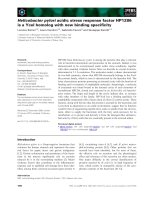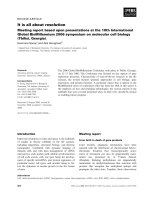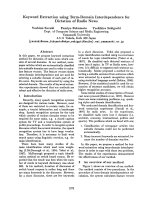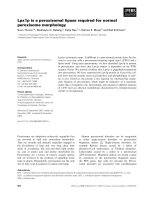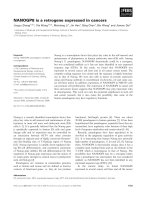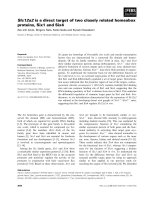Báo cáo khoa học: "Age is not a limiting factor for brachytherapy for carcinoma of the node negative oral tongue in patients aged eighty or older" docx
Bạn đang xem bản rút gọn của tài liệu. Xem và tải ngay bản đầy đủ của tài liệu tại đây (224.78 KB, 7 trang )
RESEARCH Open Access
Age is not a limiting factor for brachytherapy for
carcinoma of the node negative oral tongue in
patients aged eighty or older
Hideya Yamazaki
1*
, Ken Yoshida
2
, Tadayuki Kotsuma
3
, Yasuo Yoshioka
3
, Masahiko Koizumi
3
, Souhei Furukawa
4
,
Naoya Kakimoto
4
, Kimishige Shimizutani
3
, Tsunehiko Nishimura
1
Abstract
Background: To examine the role of brachytherapy for aged patients 80 or more in the trend of rapidly increasi ng
number.
Methods: We examined the outcomes for elderly patients with node negative oral tongue cancer (T1-3N0M0)
treated with brachytherapy. The 21 patients (2 T1, 14 T2, and 5 T3 cases) ranged in age from 80 to 89 years
(median 81), and their cancer was pathologically confirmed. All patients underwent definitive radiation therapy,
with low dose rate (LDR) Ra-226 brachytherapy (n = 4; median 70Gy), with Ir-192 (n = 12; 70Gy), with Au-198
(n = 1) or with high dose rate (HDR) Ir-192 brachytherapy (n = 4; 60 Gy). Eight patients also underwent external
radiotherapy (median 30 Gy). The period of observation ranged from 13 months to 14 years (median 2.5 years).
We selected 226 population matched younger counterpart from our medical chart.
Results: Definitive radiation therapy was completed for all 21 patients (100%), and acute grade 2-3 mucositis
related to the therapy was tolerable. Local control (initial complete response) was attained in 19 of 21 patients
(90%). The 2-year and 5-year local control rates were 91%, (100% for T1, 83% for T2 and 80% for T3 tumors after
2 years). These figures was not inferior to that of younger counterpart (82% at 5-year, n.s.). The cause-specific
survival rate was 83% and the regional control rate 84% at the 2-years follow-up. However, 12 patients died
because of intercurrent diseases or senility, resulting in overall survival rates of 55% at 2 years and 34% at 5 years.
Conclusion: Age is not a limiting factor for brachytherapy for appropriately selected elderly patients, and
brachytherapy achieved good local control with acceptable morbidity.
Background
Oral tongue carcinoma is a highly curable cancer when
treated with radiation therapy, especially interstitial bra-
chyt herapy [1]. Iridium-192 (Ir-192) hairpins or cesium-
137(Cs-137) needles are usually used for low-dose-rate
(LDR) interstitial radiotherapy in Japan. We used a
high-dose-rate (HDR) remote-controlled after-loading
system, using an Ir-192 microsource, the MicroSelec-
tron-HDR (Nucletron, Veenendaal, The Netherlands)
installed in 1991. Since with this sy stem there is no risk
of radiation exposure except to the patient, HDR makes
it possible to treat patients in a normal ward, so that
the quality of life during t reatment may be better. We
have already reported on the outcome of HDR bra-
chytherapy for early oral tongue cancer which included
a prospective Phase III study [2-4]. In addition, we
reported that the efficacy of brachytherapy for T3 oral
tongue cancer, especially when using HDR, was
enhanced by its excellent dose distribution [5]. The
number of elderl y patient s in Japan has been increasing
steadily because of advances in both health and medical
care and the leading cause of death among the elderly is
cancer. The number of people aged 80 or over reached
7,130,000 in Japan in 2007, which count s for more than
5% of the population. The problems involved in treating
older patients with cancer are time pressing [6].
* Correspondence:
1
Department of Radiology, Kyoto Prefectural University of Medicine, 465
Kajiicho Kawaramachi Hirokoji, Kamigyo-ku, Kyoto 602-8566 Japan
Full list of author information is available at the end of the article
Yamazaki et al. Radiation Oncology 2010, 5:116
/>© 2010 Yamazaki et al; licensee BioMed Cen tral Ltd. This is an Open Access articl e distributed under the terms of the Creative
Commons Attribution License (http://creativeco mmons.org/licenses/by/2.0), which permits u nrestricted use, distribution, and
reproduction in any medium, pro vided the original work is properly cite d.
As aging is a highly individualized process, the indica-
tion, strategy, and techniques of radi ation therapy for
the elderly should not be defined exclusively by chrono-
logic landmarks [6]. We studied 21 80-year-old or older
patients with oral tongue cancer treated by brachyther-
apy. Since to the best of our knowledge, there have
been no previous reports regarding such patients, we
conducted this retrospective review of the feasibility of
brachytherapy for elderly patient with T1-3N0 oral ton-
gue cancer.
Methods
Patients
Between 1967 and 2004, 21 patients (9 males and 12
females) with previously untreated mobile tongue cancer
were treated with radiotherapy at Osaka University Hos-
pital and Osaka National Hospi tal. Patients treated with
radiotherapy combined with chemotherapy were
excluded from the study. All tumors were histologically
identified as squamous cell carcinoma. Table 1 lists
patient and treatment characteristics. The patients’ med-
ian age was 81, ranging from 80 to 89. There were 2 T1,
14 T2, and 5 T3 tumors (UICC TNM classification of
1987). During the study period, we also treated about
700 patients with T1-3N0 oral tongue carcinoma [4],
with the elderly group accounting for 3% of all patients.
Theageofthe21patientsrangedfrom80to89years
(median 81) at the start of radiation therapy, and the
male-to-female ratio was 9:12. Performance status (PS)
was classified as 0-1, based on the World Health Orga-
nization classification. For this study, the clinical records
of consecutive these 21 patients from our database were
reviewed (Table 1). To compare the result of treatment
to younger counterpart, we reviewed p opulation
adjusted (sex, T-stage, with external radiotherapy) 226
patients treated during same time period. The back-
ground comparison was shown in Table 2.
Radiation therapy
All implantation was done under local anesthesia. For
patients in the LDR group, the treatment sources con-
sisted of an Ir-192 pin for 12 patients, a Ra-226 needle
for 4 and a
198
Au grain for one patient. Each needle was
implanted wit h the Paterson-Parker system using a
reference point 5 mm distant from th e implant plane.
ThemediandoseandrangefortheLDRgrouptreated
with brachy therapy only was 70 Gy (61-84 Gy). Patients
in the HDR group received a total dose of 60 Gy in ten
fractions during one week at 5 mm distance from the
radioactive source. Two fractions were administered per
day. The time interval between fractions was more than
6 hours. Dose rates at the reference points for t he LDR
group were 0.30 to 0.8 Gy/h, and for the HDR group
1.0 to 3.4 Gy/min. Patients were followed up for at least
13 months or until their death, with a median follow-up
time of 2.5 years (range: 1.3 - 14 years) . Large T2 tumor
or more including ulceration or thicker tumor received
external irradiation. A total of 8 patients (T2: 3, T3: 5)
underwent external radiotherapy using a Co-60 telether-
apy unit or a linear accelerator. These patients received
2-3 Gy per fraction for a median dose of 30 Gy (30 - 50
Gy), and were treated with a single lateral field that
involved the primary site and the upper jugular lymph
nodes. Nutrition support was given by nasal tube feed-
ing during brachytherapy. No patient required tracheost-
omy. The routine follow-up interval was 1 month for
the first year, two months for the second year, and 3 -
6 months thereafter. We examined the outcomes in
term s of local control, lymph node control, cause-speci-
fic and overall survival. Early toxicities were assessed by
Common Toxicity Criteria version 3 (CTC v3). Late
toxicities were counted if soft tissue (ulceration lasting
3 months or more) and/or bone (bone exposure and
necrosis) reactions occurred.
Statistical Analysis
For a statistical analysis, a Student’s t-test for normally dis-
tributed data and the Mann Whitney U-test for skewed
data were used. The percentage was analyzed using a Chi-
square test. Local control and survival data were estimated
according to the Kaplan-Meier method, and were exam-
ined for significance with a logrank test. All analyses used
the conventional p < 0.05 levels of significance.
Results
Local control, regional control, cause-specific and overall
survival
The 2- and 5-year local control rates for the 21 e lderly
patients were both 91% (Figure 1). The 2-year (5-year)
local control rates for T1, T2, T3 tumors were 100%
(100%), 83%, (83%) and 80% (not availabl e), respectively
(n.s.). These figures was not inferior to that of younger
counterpart (82% at 5-year, Figure 2 n.s.). Two patients
showed local recurrence. An 83-year-old female (ID15)
received external radiotherapy for lymph node metasta-
sis found just after completion of brachytherapy, but
local recurrence appeared and resulted in death. One
more local failure occurred in an 80-year-old female
with T2N0 oral tongue cancer (ID 19) treated with the
Ir-192 source. During the first night of treatment in
the RI wa rd, she tried t o brush her teeth and pulled out
the guide gutter of the Ir-192, so that the Ir-192 needles
were replaced with Au-198, resulting in partial response
and recurrence 4 months later. The 2-year and 5-year
cause-specific survival (CSS) rates were both 83% (83%
and 78% in control group), but the respective overall
survival rates were 55% and 34% (83% and 76% in con-
trol group). Incidence of lymph-node metastasis was
Yamazaki et al. Radiation Oncology 2010, 5:116
/>Page 2 of 7
Table 1 Characteristics and clinical background of the study population
No. Sex Age T Longest
diameter
Short
diameter
Thickness Tumor
type
External
RT dose
Brachytherapy
dose
Radioactive
Source
Initial
response
Survival Disease
control
Outcome Complications Comorbidity
(year) (mm) (mm) (mm) (Gy) (Gy) (year) (status)
1 F 86 2 25 15 5 exo 73 Ir CR 1.2 NED DID
2 F 85 2 25 13 5 sup 30 60 Ra CR 7 NED DID
3 M 82 1 20 11 5 sup 70 Ra CR 2 NED DID (senile decay)
4 F 82 1 20 7 3 exo
+ulc
65 Ir CR 6 NED DID (senile decay) Hypertention
5 M 82 2 35 23 15 ins+ulc 30 60 Ir CR 3 NED DID
6 M 82 2 25 12 10 NA 68 Ir CR 1 NED Alive TIA
7 F 81 2 25 12 10 ulc 76 Ir CR 14 nodal
failure
4M
Alive (salvaged by
surgery)
8 F 82 2 38 17 10 ind 48 ms CR 2.5 NED Alive Ulcer and bone
exposure after
biopsy
9 M 81 2 24 15 12 ind 60 Ir CR 1.4 nodal
failure
8M
Dead (nodal
failure)
10 F 80 2 23 7 5 ind 70 Ir CR 12 NED DID (senile decay) Hypertention
11 M 80 2 23 18 7 exo 75 Ir CR 6 NED Alive Hypertention
12 M 80 2 NA NA NA NA 70 Ir CR 2 NED DID
13 M 80 3 42 25 25 ulc 33 60 ms CR 1.4 NED DID
14 M 80 3 42 23 13 ulc+ind 30 85 Ra CR 3 NED DID (senile decay)
15 F 83 3 42 20 20 ulc+ind 30 70 Ra PR 1 nodal
failure
0M
Dead (nodal
failure and local
failure)
16 F 89 3 50 30 20 ulc+ind 36 32 ms CR 1.3 NED DID
17 F 83 2 31 24 8 ind
+exo
70 Ir CR 4 NED DID
18 M 81 3 35 28 15 ulc+ind 36 54 Ir CR 0.9 NED DID
19 F 80 2 25 20 10 ind 70 Au PR 1.8 local
failure
4M
Dead (local failure)
20 F 80 2 25 20 6 ind 50 54 Ir CR 2 NED Alive
21 F 82 2 27 22 12 exo 54 ms CR 2 NED Alive Mild ulcer, pain
Ir; Ir-192, Ra; Ra-226, ms; Ir-192 microSelectron-HDR, Au; Au-198 grain
sup; superficial type, exo;exophytic type, ind; indurative type, ulc; ulcerative type
DID; died for intercurrent disease, DT; death for tongue cancer, NED; no evidence of disease, NA; not avairalble
TIA; transient ischemic attack
Yamazaki et al. Radiation Oncology 2010, 5:116
/>Page 3 of 7
Table 2 Background of aged patients and younger conterpart
Aged (80-) Control (-79)
(N = 21) (N = 226)
Age Age Median (Range) 81 (80-89) 56 (18-79)
Gender Male 9 (43%) 101 (45%)
Female 12 (57%) 125 (55%)
T classification T1 2 (10%) 30 (13%)
T2 14 (67%) 146 (65%)
T3 5 (24%) 50 (22%)
Long diameter (mm) 30 ± 8 26 ± 9
Short diameter (mm) 18 ± 7 18 ± 8
Thickness (mm) 11 ± 6 9 ± 6
Source Ra-226 4 (19%) 72 (32%)
Ir-192 12 (71%) 120 (63%)
Au-198 1 (5%) 0 (0%)
MS-HDR 4 (19%) 34 (15%)
External radiotherapy Brachytherapy only 13 (80%) 165 (73%)
Combined with external radiotherapy 8 (20%) 61 (27%)
Prescribed dose Brachytherapy Median (Range)(Gy) LDR 70 (54-85) 70 (50-112)
HDR 54 (32-60) 60 (42-60)
External radiotherapy Median (Range)(Gy) LDR 30 (12-60)
HDR; high dose rate, LDR; low dose rate
0
.2
.4
.6
1
0 10 15
y
ears
.8
Probability
91
᧡
83
᧡
34
᧡
5
Overall survival rate
Cause specific survival rate
Local control rate
Figure 1 Local control, cause specific survival and overall survival rates for patients 80 or more with oral tongue cancer treated with
interstitial radiotherapy. solid line; local control rate, dotted line; cause specific survival rate, dashed line; overall survival rate.
Yamazaki et al. Radiation Oncology 2010, 5:116
/>Page 4 of 7
21% at 2 years (34% in control group) and all four
recurerce appeared at ipsilateral side. Of the 4 patients
who showed nodal failure, three underwent surgery, one
of whom could be salvaged. Actuarially 12 patien ts died
because of intercurrent disease or o ld age. The follow-
up for 5 patients had to be terminated because the
patients or their family requests.
Tolerance and Complications
Grade 2-3 acute mucositis, pharyngitis for combined
external radiotherapy and oralmucositisforsolelybra-
chytherapy, occurred but were acceptable. No grade-4
skin or mucosal acute reactions were documented. The
intensity of acute reactions in the elderly patients was
almost the same as that observed in younger patients.
Late reactions after brachytherapy comprised one bone
exposure and/or two ulcer formations lasting 3 months
more (2/21 = 10%; Table 1). One case showed tongue
deformati on with ulceration scar. In previous coho rt [4],
10 to 30% of delayed reaction was found according to
treat ment volume and addition of external radiotherapy.
Aged patients showed similar ratio of delayed reaction.
Discussion
The patients 80 years old or older among those who
were treated by brachytherapy accounted for about 3%
of our cohort. The incidence of carcinogenesis among
this age group is c urrently unavailable, but oncologists
are treating increasing numbers of elderly cancer
patients, so that we should be more deeply concerned
about treatment strategies for these patients. The dete-
rioration of biological functions associated with aging
leads to a diminished reserve capacity and increased vul-
nerability to age-related diseases and overall forces of
mortality [6-8]. As the effects of aging depend on the
individual, they manifest themselves with great variabil-
ity and heterogeneity, thus making it extremely difficult
ifnotimpossibletodetermineastandardtherapyfor
elderly patients based only on chronologic landmarks.
When deciding on a personalized mode of treatment for
older patients, it is important to assess each patient’s
quality of life and life expectancy. Prognostic factors
related to the tumor (TNM stage, pathology, etc.), physi-
cal and/or psychological status (PS, etc.), and social sup-
port should be taken into account when estimating the
outcome of treatment and life expectancy of elderly
patients. However, the major part of prospective trials is
carried out with patients younger than 70 so that little
evidence regarding elderly patients is available.
Generally, local treatment is more appropriate than
systemic therapy for the elderly. Standard chemotherapy,
especially combination treatment, is not encouraged
91᧡
᧡
Local control rates
year
s
82
᧡
0
.2
.4
.6
.8
1
0 2 5 10
226
21
176
10
118
5
65
1
Patients at risk Age - 79
80
-
Figure 2 Local control rates according to age. Aged patients 80 or more showed no inferior local control rate to younger counterpart.
Yamazaki et al. Radiation Oncology 2010, 5:116
/>Page 5 of 7
because of elderly patients’ physiologically impaired
functions and diminished reserve capacity of important
organs [9-11]. Unsatisfactory outcomes of c ombination
therapy have been reported [8], although better results
with less toxic antineoplastic agents or reduced doses of
chemotherapeutic agents especially designed for elderly
patients with non-Hodgkin’ s lymphoma have been
reported [12]. Moreover, the rates of acute adverse
effects, morbidity, and mortality remain high for the
elderly, so that extended radical surgery is not encour-
aged for the same reasons. It is important for their qual-
ity of life and life expectancy to attain local control of
symptomatic primary lesions. Carefully planned radia-
tion therapy for the elderly is expected to become
increasingly important [13]. A prospective study has also
reported the usefulness of radiotherapy for esophageal
cancer in elderly patients [14], and found that patients
with good PS could tolerate doses that administered
according to a standard radiotherapy schedule [9]. Our
findings agreed with this study in that the completion
rate of radiotherapy and local control rate for elderly
patients were not inferior to those for younger patients.
One of the limitations of this study is that its retro-
spective nature leads to a lack of detailed information
about co-morbidity. This is important because cardio-
vascular and pulmonary diseases as well as diabetes and
other diseases are more pronounced in elderly than
younger patients. In addition, as mentioned in results,
unexpected accidents will occur more frequently in
elderly than younger patients. We found four case s of
hypertention and a TIA records in patients’ charts, how-
ever, they were able to be diagnosed as candidates for
brachytherapy with local anesthesia and we noted that
adverse reactions such as mucosi tis in HDR brachyther-
apy were similar for elderly patients: spotted mucositis
started to appear three days after the end of brachyther-
apy while confluent mucositis developed and reached a
peak at ten days, but disappeared by the fourth to eighth
week without any major complications [2]. Fortunately,
we did not encounter the aspiration pneumonia after
brachytherapy in current study. Severe deterioration in
QOL, such as speech disturbance, swa llowing function
loss, and frequent short hospital stay were also not a
case enhanced than younger counterpart. Although the
number of patients in this series was too small to draw
definite conclusions regarding efficacy, late toxicity and
tolerance, our d ata suggest the potential benefits of bra-
chytherapy for elderly patients.
Because radiation therapy is considered to be a mini-
mally invasive treatment procedure, it has the advantage
of preserving the shape and functions of the tongue.
Brachytherapy was historically performed with Ra-226,
which involved exposure of the surrounding tissue. To
minimize undesirable radiation to normal tissues, an
afterloading technique using Ir-192 was implemented.
This LDR brachytherapy has been widely used since and
become the gold standard in brachytherapy. Many insti-
tutes have reported successful results for tongue cancer
treated with LDR brachytherapy [2,15]. Since then, HDR
brachytherapy using a remote afterloading technique has
been introduced in several brachytherapy centers,
including ours [2-4]. We previously reported our phase
III data and a retrospective review with good results for
T1-3 N0 patients to sho w the comparable outcome of
HDR. However, retrospective reviews including ours
reported that older patients aged 65 or over showed
poorer local control than their younger counterparts
[3,4]. In a 648-patient cohort, 5-year local control rates
were 87% for T 1, 78% for T 2, and 68% for T3 in
younger patients, but 72% for T1, 67% for T2, and 54%
for T3 in elderly patients aged 65 or over (p < 0.05) [4].
These findings prompted us to examine the background
characteristics of older patients. We found that one pos-
sible explanation for poor local control was poor oral
hygiene including dental factors in the elderly in pre-
vious study [12], which could be modified by careful
intervent ion. In addition, in the study reported here, we
found that patients aged 80 or over showed good out-
come including four locally controlled HDR patients.
Therefore age is not a sole factor on a local control rate
by brachytherapy, other confounding factor such as
tumor, oral hygiene, PS, c o-morbidities have affected
outcomes. Although further studies are needed to estab-
lish optimum schedules and techniques, elderly patients
with good PS may tolerate brachytherapy schedules so
that the advisability of definitive radiation therapy
should be considered.
In conclusion, patients aged 80 or over showed results
comparable to those for their younger counterparts, and
an aggressive approach for appropriately selected elderly
patients achieved good local control.
Author details
1
Department of Radiology, Kyoto Prefectural University of Medicine, 465
Kajiicho Kawaramachi Hirokoji, Kamigyo-ku, Kyoto 602-8566 Japan.
2
Department of Radiology, National Hospital Organization, Osaka National
Hospital, Hoenzaka 2-1-14 Chuo-ku, Osaka city, Osaka 540-0006 Japan.
3
Department of Radiation Oncology, Osaka University Graduate School of
Medicine, Yamadaoka 2-2, Suita, 565-0871 Osaka, Japan.
4
Department of
Maxillo-Facial Radiology, Osaka University Graduate School of Densitry,
Yamadaoka 1-8, Suita, 565-0871 Osaka, Japan.
Authors’ contributions
HY conceived of this study and drafted manuscript. KY participated in the
design of this study. TK and YY participated in the statistical analysis. MK, SF,
NK, KS and TN participated in its design and coordination and helped to
draft the manuscript. All authors read and approved the final manuscript.
Competing interests
The authors declare that they have no competing interests.
Yamazaki et al. Radiation Oncology 2010, 5:116
/>Page 6 of 7
Received: 6 October 2010 Accepted: 9 December 2010
Published: 9 December 2010
References
1. Mazeron JJ, Crook JM, Benck V, Marinello G, Martin M, Raynal M, Haddad E,
Peynègre R, Le Bourgeois JP, Walop W: Iridium 192 implantation of T1
and T2 carcinomas of the mobile tongue. Int J Radiat Oncol Biol Phys
1990, 19:1369-1376.
2. Inoue T, Inoue T, Yoshida K, Yoshioka Y, Shimamoto S, Tanaka E,
Yamazaki H, Shimizutani K, Teshima T, Furukawa S: Phase III trial of high vs.
low dose rate interstitial radiotherapy for mobile tongue cancer. Int J
Radiat Oncol Biol Phys 2001, 51:171-175.
3. Yamazaki H, Inoue T, Yoshida K, Imai A, Yoshioka Y, Tanaka E, Shimamoto S,
Nakamura S, Inoue T, Nakamura H, Furukawa S, Shimizutani K: Influence of
age on the results of brachytherapy for tongue cancer. Int J Radiat Oncol
Biol Phys 2001, 49:931-936.
4. Yamazaki H, Inoue T, Yoshida K, Yoshioka Y, Furukawa S, Kakimoto N,
Shimizutani K: Comparison of three major radioactive sources for
brachytherapy used in the treatment of node negative T1-T3 oral
tongue cancer: influence of age on outcome. Anticancer Res 2007,
27:491-497.
5. Kakimoto N, Inoue T, Inoue T, Murakami S, Furukawa S, Yoshida K,
Yoshioka Y, Yamazaki H, Tanaka E, Shimizutani K: Results of low- and high-
dose-rate interstitial brachytherapy for T3 mobile tongue cancer.
Radiother Oncol 2003, 68:123-128.
6. Monfardini S, Yancik R: Cancer in the elderly: Meeting the challenge of an
aging population. J Natl Cancer Inst 1993, 85:532-538.
7. Rodin MB, Mohile SG: A practical approach to geriatric assessment in
oncology. J Clin Oncol 2007, 25:1936-44.
8. Sanoff HK, Bleiberg H, Goldberg RM: Managing older patients with
colorectal cancer. Clin Oncol 2007, 25:1891-7.
9. Pignon T, Horiot JC, Bolla M, van Poppel H, Bartelink H, Roelofsen F, Pene F,
Gerard A, Einhorn N, Nguyen TD, Vanglabbeke M, Scalliet P: Age is not a
limiting factor for radical radiotherapy in pelvic malignancies. Radiother
Oncol 1997, 42:107-120.
10. Bourhis J, Overgaard J, Audry H, Ang KK, Saunders M, Bernier J, Horiot JC,
Le Maître A, Pajak TF, Poulsen MG, O’Sullivan B, Dobrowsky W, Hliniak A,
Skladowski K, Hay JH, Pinto LH, Fallai C, Fu KK, Sylvester R, Pignon JP, Meta-
Analysis of Radiotherapy in Carcinomas of Head and neck (MARCH)
Collaborative Group: Hyperfractionated or accelerated radiotherapy in
head and neck cancer: a meta-analysis. Lancet 2006, 368:843-54.
11. Pignon JP, le Maître A, Maillard E, Bourhis J, MACH-NC Collaborative Group:
Meta-analysis of chemotherapy in head and neck cancer (MACH-NC): an
update on 93 randomised trials and 17,346 patients. Radiother Oncol
2009, 92:4-14.
12. O’Reilly SE, Connors JM, Howdle S, Hoskins P, Klasa R, Klimo P, Stuart DS: In
search of an optimal regimen for elderly patients with advanced-stage
diffuse largecell lymphoma: Results of a Phase II study of P/DOCE
chemotherapy. J Clin Oncol 1993, 11:2250-2257.
13. Oguchi M, Ikeda H, Watanabe T, Shikama N, Ohata T, Okazaki Y, Ohata T,
Okazaki Y, Kiyono K, Sone S:
Experiences of 23 patients > or = 90 years of
age treated with radiation therapy. Int J Radiat Oncol Biol Phys 1998,
41:407-13.
14. Kawashima M, Kagami Y, Toita T, Uno T, Sugiyama M, Tamura Y, Hirota S,
Fuwa N, Hashimoto M, Yoshida H, Shikama N, Kataoka M, Akuta K, Sasaki K,
Tamamoto T, Nemoto K, Ito H, Kato H, Yamada S, Ikeda H: Prospective trial
of radiotherapy for patients 80 years of age or older with squamous cell
carcinoma of the thoracic esophagus. Int J Radiat Oncol Biol Phys 2006,
64:1112-21.
15. Yamazaki H, Inoue T, Yoshida K, Kotsuma T, Yoshioka Y, Koizumi M,
Furukawa S, Kakimoto N, Shimizutani K, Nishimura T: Assessment of
influence of smoking, drinking, leukoplakia and dental irritation on Local
Control of Early Oral Tongue Carcinoma Treated with Brachytherapy:
Age and Dental Factor are potential Prognostic Factors. Tumori 2009,
95:461-6.
doi:10.1186/1748-717X-5-116
Cite this article as: Yamazaki et al.: Age is not a limiting factor for
brachytherapy for carcinoma of the node negative oral tongue in
patients aged eighty or older. Radiation Oncology 2010 5:116.
Submit your next manuscript to BioMed Central
and take full advantage of:
• Convenient online submission
• Thorough peer review
• No space constraints or color figure charges
• Immediate publication on acceptance
• Inclusion in PubMed, CAS, Scopus and Google Scholar
• Research which is freely available for redistribution
Submit your manuscript at
www.biomedcentral.com/submit
Yamazaki et al. Radiation Oncology 2010, 5:116
/>Page 7 of 7

